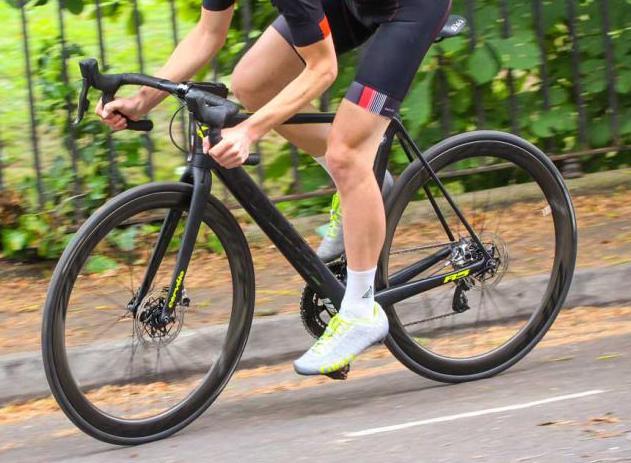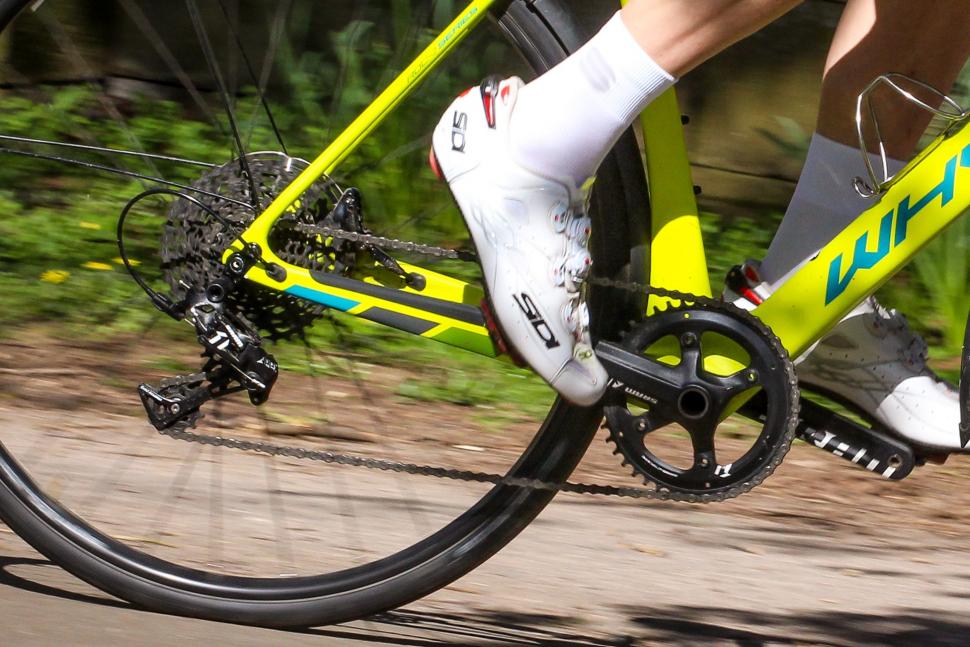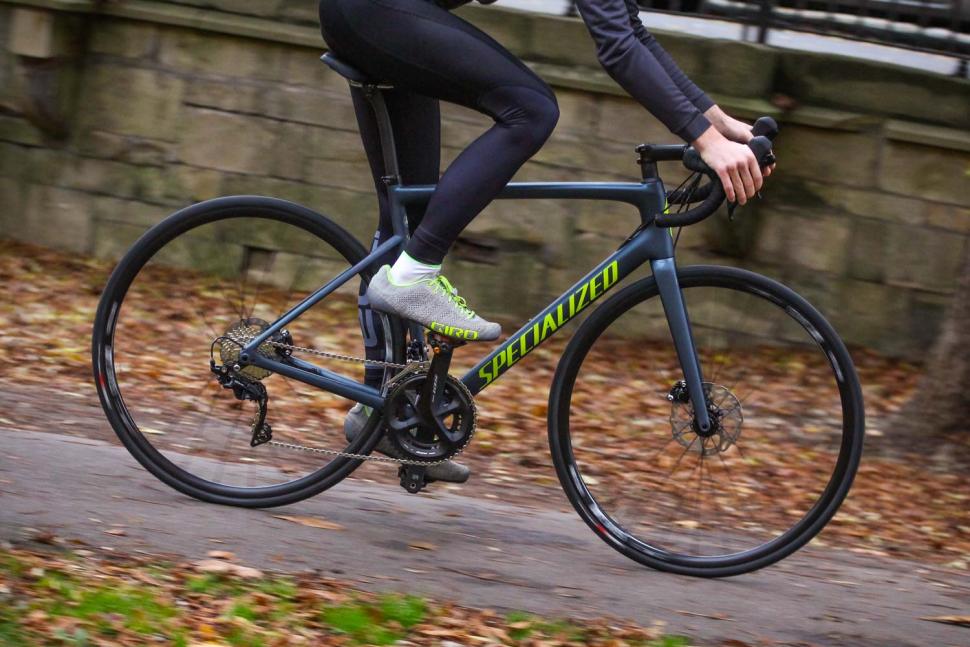- News
- Reviews
- Bikes
- Accessories
- Accessories - misc
- Computer mounts
- Bags
- Bar ends
- Bike bags & cases
- Bottle cages
- Bottles
- Cameras
- Car racks
- Child seats
- Computers
- Glasses
- GPS units
- Helmets
- Lights - front
- Lights - rear
- Lights - sets
- Locks
- Mirrors
- Mudguards
- Racks
- Pumps & CO2 inflators
- Puncture kits
- Reflectives
- Smart watches
- Stands and racks
- Trailers
- Clothing
- Components
- Bar tape & grips
- Bottom brackets
- Brake & gear cables
- Brake & STI levers
- Brake pads & spares
- Brakes
- Cassettes & freewheels
- Chains
- Chainsets & chainrings
- Derailleurs - front
- Derailleurs - rear
- Forks
- Gear levers & shifters
- Groupsets
- Handlebars & extensions
- Headsets
- Hubs
- Inner tubes
- Pedals
- Quick releases & skewers
- Saddles
- Seatposts
- Stems
- Wheels
- Tyres
- Health, fitness and nutrition
- Tools and workshop
- Miscellaneous
- Tubeless valves
- Buyers Guides
- Features
- Forum
- Recommends
- Podcast
feature
 Pedalling closeups - 1
Pedalling closeups - 1Cycling cadence: how fast should you pedal?
Study after study finds that lower cycling cadence is more efficient. So should you stop trying to pedal at 90+ revolutions per minute and instead diesel along at around 60rpm? Maybe it's not quite that simple.
We all saw that article: High cadence pedalling is inefficient for amateurs, says new study. Oh how we all laughed that the study used inappropriate people (non-trained cyclists) and thus the conclusion can’t be considered relevant for us lot who are out bashing it up and down the lanes, on the turbo, or wherever.
But let’s get this over and done with, I’ll just come right out and say it: the study is correct. “What? I pedal best at 90 odd revolutions per minute and feel like it’s best at this cadence,” I hear you shouting at me. And, do you know what? That’s exactly how I feel too!
Interestingly, efficiency in cyclists has been studied for a long period of time. I’m keeping this honest; I don’t know the exact answer to my next statement, but I’m going to suggest that cycling efficiency must have been first studied in the early part of the twentieth century.
Searching quickly on PubMed, I find this article (in German): “Relation between force and force perception as a basis for the selection of energetically unfavourable pedalling frequencies in cycling” (Stegemann, et al, 1968. Click on the link for details of the study, or check out the list at the bottom of the page).
My take away from that title alone is that cyclists prefer pedalling at a moderate to high cadence, and that this is somehow unfavourable, and that force perception (how it feels at the pedals) is how we (in part) choose cadence. If I’ve summarised that article correctly, then it should mean that prior to this article being written researchers already knew that moderate/high cadence was inefficient. I know, I’m going out on a limb with this, but bear with me please.
Suzuki showed that in people who had predominantly slow twitch muscle fibres (as you’d expect with endurance athletes) efficiency dropped from 23.3% at 60 rpm to 19.6% at 100 rpm.
Coast et al showed that in trained bicycle racers riding at around 85% of VO2max (probably around the effort you could sustain maximally for approximately two hours) the best cadences across a range of measures (efficiency, lactate, HR, perceived exertion) were either 60 or 80 rpm.
Sidossis showed that the oxygen cost of unloaded cycling increased as pedalling cadence increases at 60, 80, and 100 rpm. This means you’re having to expend more energy when you pedal faster.
These research papers, plus many others, all show essentially the same thing: gross efficiency at a given power output is higher at lower cadences, with most research showing about 60 rpm as the most efficient.
Okay, all these studies are old, maybe newer techniques will show that higher cadences are more efficient in trained cyclists.
Leirdal and Ettema looked at a variety of cadences at around 75% VO2max, including the athletes’ freely chosen cadence. Bingo! They found exactly the same: efficiency was highest at lower cadences including 10 rpm below the athletes’ freely chosen cadence. Whichever way it’s diced, lower is more efficient.
In case anything changed out in the field, Nimmerichter et al looked at 60 rpm versus 90 rpm at a fixed power output, on level roads and uphill, using really well trained cyclists. Unsurprisingly, 60 rpm in both conditions was more efficient than 90 rpm.
Spin to win?
If you’ve ever been on a club run or been coached, you’ll probably have been told to keep your cadence in the 90s. Spin to win. Are there any positive reasons to do that?
Interestingly, yes! The above studies – and others – show that as your power output increases so does the most efficient cadence (but it’s still lower than freely chosen cadence).
Anything else? Yes. Beneke and Alkhatib showed that higher cadences reduce carbohydrate oxidation. This means that a reliance on carbohydrates is reduced, sparing those all-important carbs for when they’re really needed – smacking it to the top of a hill, beating your mates, or accelerating and ragging it to the finish line over the last couple kilometres of a road race.
Indeed, in road racing or a smash fest with your mates, you might find that the pace (on the same terrain) changes rapidly. If you’re riding in a big gear at low cadence in order to maintain a high efficiency, you just can’t react to those accelerations and you’re quite possibly going to be booted out the back of the peloton while you try to wind up the gear you’re in. Even if you change down and try to bring your cadence up, there’s a good chance you’ll struggle.
Lastly, I think we also need to go back to the German study. Our perception of the workload (power output) is reduced at higher cadences due to the smaller forces needed to get the pedals over. At lower cadences you need a higher force to maintain a given power output compared to a lower force at higher cadence. It’s like lifting a smaller weight more times than lifting a bigger weight fewer times. We know from the Beneke work that carb usage goes down at higher cadence but efficiency is decreased. It just feels easier to maintain the same power at a higher cadence.
Ultimately, though, efficiency in this respect just isn’t important. Yes, you might well expend more energy by pedalling faster (that’s probably no bad thing for most of us, especially if you want an extra piece of cake), but it’s more important to feel that the power is manageable (forces are lower), and to spare that all important carbohydrate, so let’s spin to win!
References
Stegemann J, Ulmer HV, & Heinrich KW. (1968). Internationale Zeitschrift fur Angewandte Physiologie. “Relation between force and force perception as basis for the selection of energetically unfavourable pedalling frequencies in cycling”.
Suzuki Y. (1979). Journal of Applied Physiology: Respiratory, Environmental, and Exercise Physiology. “Mechanical efficiency of fast and slow twitch muscle fibers in man during cycling”.
Coast JR, Cox RH, Welch HG. (1986). Medicine and Science in Sport and Exercise. “Optimal pedalling rate in prolonged bouts of cycle ergometry”.
Sidossis LS, Horowitz JF, Coyle EF. (1992). International Journal of Sports Medicine. “Load and velocity of contraction influence gross and delta mechanical efficiency”.
Leirdal S and Ettema G. (2011). European Journal of Applied Physiology. “The relationship between cadence, pedalling technique and gross efficiency in cycling”.
Nimmerichter A, Prinz B, Haselsberger K, Novak N, Simon D, Hopker JG. (2015). International Journal of Sports Physiology and Performance. “Gross efficiency during flat and uphill cycling in field conditions”.
Beneke R, and Alkhatib A. (2015). Biology of Sport. “High cycling cadence reduces carbohydrate oxidation at given low intensity metabolic rate”.
Ric Stern established RST Sport in 1998 and has been using an evidence-based approach to coaching to help grassroots athletes to world-class athletes perform at their best. Ric can be reached through www.cyclecoach.com.
Latest Comments
- ktache 4 hours 25 min ago
The batteries were not the easiest to find, and the brackets broke easily. The switch was far better than the D cell quick release ever readys that...
- ktache 4 hours 51 min ago
There are people out there who will make you the belt out of your old tyre.
- chrisonabike 4 hours 53 min ago
Furry dice and an air freshener for your helmet.
- AidanR 5 hours 5 min ago
Looking at the pictures in the linked article, the bikes aren't actually inconsiderately parked. The only issue is that they're on private property...
- Simon E 5 hours 41 min ago
Ah yes, those are hopefully not the 'master craftsmen' that has constructed a wide range of shoddy Italian cars and motorbikes over the years with...
- Simon E 6 hours 3 min ago
A SuperSix is definitely not an all-rounder....
- JLasTSR 6 hours 9 min ago
Since most of.my clothes come.from.charity shops.or the eBay nearly for.nothing clothing section I don't tend.to.worry if they wear out, I am also...
- chrisonabike 6 hours 55 min ago
Just get them to walk a treadmill - or better, ride exercise bikes to power path lighting.
- AidanR 7 hours 31 min ago
So his advisers were trying to move funds around to cover losses, but in a way that needlessly created additional liabilities? It would have been...



Add new comment
45 comments
Spinning doesn’t work for me. I’ve got long legs so there’s a lot of “stuff” to move. Long cranks, more leverage and bigger gears works best in my personal experience and maintaining good form gets more difficult the higher the cadence goes so my knees are actually happier
I aim to cycle around 80 for the simple reason it lowers the risk of knee strain. I am not an expert but I have read this and personally experienced knee strain.
I aim to cycle around 80 for the simple reason it lowers the risk of knee strain. I am not an expert but I have read this and personally experienced knee strain.
I aim to cycle around 80 for the simple reason it lowers the risk of knee strain. I am not an expert but I have read this and personally experienced knee strain.
I aim to cycle around 80 for the simple reason it lowers the risk of knee strain. I am not an expert but I have read this and personally experienced knee strain.
Guess what my physio now has me doing daily
Actually not quite worked up to squats, but doing wall sits, sort-of single leg squats/lunges and lateral band-walks.
Squats seemed to give me back spasms, but working through that with physio.
quote- 'oxygen cost of unloaded cycling increased as 'pedalling cadence increases at 60, 80, and 100 rpm. This means you’re having to expend more energy when you pedal faster.'
I agree with the principal, but over 90 to 95rpm not at 60 or 80! Unloaded my HR will not increase significantly or at all at 90rpm.
This is a well written article but it's bending my head a bit.. someone delve into the research more please.. also from the summary can we take that 'pace riding in a group' low cadence isn't ideal, but for TT's lower may be better?
I found this study.
https://www.active.com/cycling/articles/why-fast-pedaling-makes-cyclists...
to cut a long story short, it agrees with the findings which say that carb oxidation is decreased at high force high Cadence pedalling
And that a trained cyclist, with good technique, will find that a cadence of 90 odd rpms will be more efficient, due to the fact there’s decreased oxygen demand from the fast twitch muscles, because of the increase d frequency but less forceful contractions of the fast twitch muscles meaning they fuel primarily from fat, this process is more oxygen efficient than the Glycogen oxidation process that occurs during high force lower frequency contractions found at 60-70 rpms. The caveat is that there has to be sufficient power being produced at the tested cadences, for this to hold true. So average boris / Doris on a bimble to the shops probably wouldn’t benefit from high Cadence pedalling, because they are unlikely to be producing the requisite power to make it work properly.
I employ different strategies for different events. I produce the most power at my threshold heart rate at 70-75rpm. I use this cadence for TT's .
However if Im riding multi back to back days, I use a much higher cadence towards 95-100rpm. I will try and use a higher cadence for most part of the day but it naturally falls as I become fatigued.
My legs dont feel blown or over tired the next day by utilising a higher cadence.
Ive tried a higher cadence for TT, but I hit my threshold HR too quickly before target power, so hence for TT I drop cadence.
Its a balance between cardio capacity and muscular capacity. I can see clearly what cadences suit what events when using software like Trainer Road.
As for myself, I’ve gone back to a more organic approach and turned everything off. I just ride now. It’s so much nicer. Don’t get me wrong I still record some data mainly speed and distance but I’m no longer a slave to data. I’ve gotten rid of the power meter, hr monitor and cadence sensor and truth be told it’s much more enjoyable for road riding. And what aided all this was getting into cyclocross this past because I realized none of that stuff matters. It’s hard enough getting around a course safely and efficiently much less trying to look down to see if I’m in the right power/ cadence or heart rate zones.
Well, as most now are aware the "Study" was on 9 "Leisure" cyclists. It concluded that a faster cadence was better for "Professional" cyclists but not for leisure cyclists.
I would say that a "Leisure " cyclist is perhaps by example a couple out for a leisurely ride two or three times a month when the weather is nice. They are not trained cyclists and so yes a cadence of 50-60 may well be more efficient for them, but ironically they are the kind of cyclist who don't care or know what their cadence is or should be, so this "study" is wasted on them.
I suggest that any trained cyclist will fall in the Professional category as far as this study is concerned.
I think there is a massive assumption not being stated here, which is force on joints/feet etc.
Granted, I seem to be pretty injury prone due to the inconsistent nature of my riding, but I would be more inclined to push bigger gears if I wasn't constantly nursing some back injury, or knee injury, or sore foot or something!
Tellingly I'm finally enjoying my riding again after ditching the winter singlespeed and spinning everywhere on the 'shoulder season' 2x11 road bike...
If we're talking about appropriate samples of riders, I would suggest you need 65%*of your sample set to be carrying some sort of of niggling injury!
*based on some study I saw somewhere about percentage of cyclists suffering a knee injury...
If you're suffering injuries that frequently can I suggest adding a small amount of bodyweight exercise into your weekly routine. A few unweighted squats (done correctly) lunges and holding a plank position really do seem to help prevent the little niggly injuries that occur. Doesn't even need to be very much of it each week, but the support it provides to knees, hips, back etc really makes a difference.
Its a good one this, but ultimately people will just do what they do by feel and listening to their legs.
Got to say I agree with this. I usually ride at an average cadence of 60 - 70. I've tried lower gears & increasing the cadence but usually end up back at 60 - 70 just going slower! Last winter I did a number of spin classes with the hope of this increasing my cadence this year - nope! Didn't work so I now just ride how I feel as JImthebikeguy says.
Pages